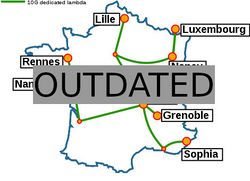Grid5000:Home
|
Grid'5000 is a large-scale and versatile testbed for experiment-driven research in all areas of computer science, with a focus on parallel and distributed computing including Cloud, HPC and Big Data. Key features:
Older documents:
|
Random pick of publications
Five random publications that benefited from Grid'5000 (at least 2777 overall):
- Rémi Meunier, Thomas Carle, Thierry Monteil. Multi-core interference over-estimation reduction by static scheduling of multi-phase tasks. Real-Time Systems, 2024, pp.1--39. 10.1007/s11241-024-09427-3. hal-04689317 view on HAL pdf
- Lucian Trestioreanu, Flaviene Scheidt, Wazen M. Shbair, Jerome Francois, Damien Magoni, et al.. To Squelch or not to Squelch: Enabling Improved Message Dissemination on the XRP Ledger. 37th IEEE/IFIP Network Operations and Management Symposium (NOMS 2024), May 2024, Séoul, South Korea. hal-04621124 view on HAL pdf
- Nicolas Amat, Pierre Bouvier, Hubert Garavel. A Toolchain to Compute Concurrent Places of Petri Nets. LNCS Transactions on Petri Nets and Other Models of Concurrency, 2023, Lecture Notes in Computer Science, 14150, pp.1-26. 10.1007/978-3-662-68191-6_1. hal-04392784 view on HAL pdf
- Marina Botvinnik, Tomer Laor, Thomas Rokicki, Clémentine Maurice, Yossi Oren. The Finger in the Power: How to Fingerprint PCs by Monitoring their Power Consumption. DIMVA 2023 - 20th Conference on Detection of Intrusions and Malware & Vulnerability Assessment, Jul 2023, Hamburg, Germany. hal-04153854 view on HAL pdf
- Hugo Pompougnac, Alban Dutilleul, Christophe Guillon, Nicolas Derumigny, Fabrice Rastello. Performance bottlenecks detection through microarchitectural sensitivity. Institut National de Recherche en Informatique et en Automatique (INRIA). 2024, pp.1-15. hal-04796942 view on HAL pdf
Latest news
Failed to load RSS feed from https://www.grid5000.fr/mediawiki/index.php?title=News&action=feed&feed=atom: Error parsing XML for RSS
Grid'5000 sites
Current funding
As from June 2008, Inria is the main contributor to Grid'5000 funding.
INRIA |
CNRS |
UniversitiesUniversité Grenoble Alpes, Grenoble INP |
Regional councilsAquitaine |


